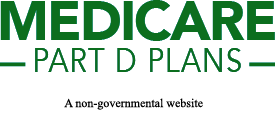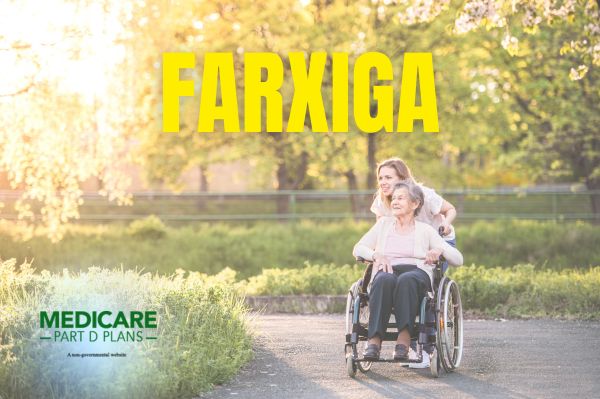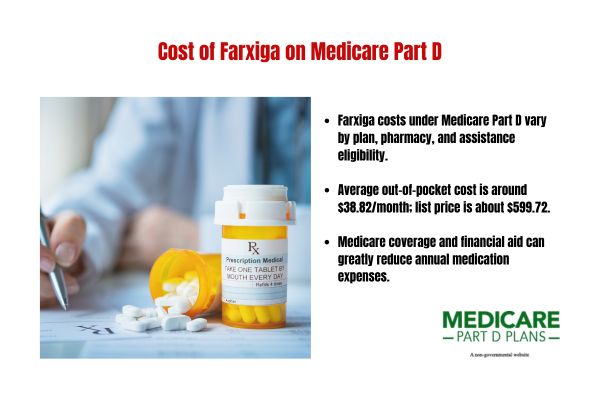Find a Medicare Part D prescription drug plan

Medicare Part D
Prescription Drug Coverage 2026
Is Farxiga Covered by Medicare Part D?
Yes, Farxiga may be covered by Medicare Part D; however, coverage might vary by plan. This article will explain how to check if is Farxiga covered by Medicare Part D, potential costs, and ways to manage expenses.
Key Takeaways
- Farxiga, used for type 2 diabetes and heart failure, may be covered under Medicare Part D depending on the plan’s specific formulary and tier classification.
- The average out-of-pocket cost for Farxiga is approximately $38.82 per month, which may be significantly less than its list price of about $599.72 for a 30-day supply, likely emphasizing the importance of Medicare coverage.
- The Inflation Reduction Act might allow Medicare to negotiate drug prices, which could potentially lead to lower costs for Farxiga and improve affordability for beneficiaries.
Understanding Farxiga
Farxiga is a medication primarily used for managing type 2 diabetes, heart failure, and chronic kidney disease. As a member of the SGLT2 inhibitors class, Farxiga works by helping to control blood glucose levels and reducing the risk of hospitalization due to heart failure.
For patients with these chronic conditions, Farxiga could offer a lifeline, significantly improving their quality of life and health outcomes.
What might set Farxiga apart from other medications may be its dual role in managing blood sugar and providing cardiovascular benefits. Farxiga could help prevent long-term complications that may be associated with diabetes, such as nerve, kidney, and eye damage, by lowering blood glucose levels.
Additionally, its ability to reduce the risk of hospitalization for heart failure could make it a critical component in the treatment plans for patients.
However, the branded drug Farxiga may come with a substantial cost, which could be a barrier for many patients. Understanding how Medicare Part D may help cover Farxiga could be essential for anyone relying on this medication.
Medicare Part D Overview
Medicare Part D is a voluntary program available to all Medicare recipients, likely providing coverage for both brand-name and generic medications through various prescription drug programs.
These plans will likely be designed to help reduce the financial burden of prescription drugs for beneficiaries, possibly ensuring they have access to necessary medications. Private, approved insurers offer these plans, and beneficiaries can enroll during specific periods to avoid late enrollment penalties.
Medicare Part D plans may vary significantly in terms of which prescription drug may be covered and the associated costs. Each Medicare plan will likely have a formulary, a list of covered drugs, which may differ from one insurer to another.
Understanding the nuances of your specific Medicare drug plan, such as the medications covered and how a drug’s tier classification will likely depend on various factors, could be crucial for managing your healthcare expenses effectively.
This variability likely underscores the importance of carefully selecting a plan that meets your needs.
Does Medicare Part D Cover Farxiga?
Whether Medicare Part D covers Farxiga will likely depend on the plan’s specific formulary:
- Private insurers that provide Medicare drug plans each have their own formularies.
- The possible inclusion of Farxiga in these formularies may vary.
- Some plans may require prior authorization before Medicare covers Farxiga.
- Some plans may require step therapy, which involves trying a more affordable medication first.
The tier classification of Farxiga within a plan’s formulary may also play a significant role in determining coverage. Typically, brand-name medications like Farxiga may be placed in higher tiers, which may result in higher out-of-pocket costs for beneficiaries.
Additionally, while pharmaceutical discount programs may provide savings, they may be not useable in conjunction with Medicare coverage for Farxiga.
This could make it even more critical to understand your Medicare drug plan’s specifics and explore the available options to help manage the cost of this medication effectively.
Cost of Farxiga on Medicare Part D
The cost of Farxiga under Medicare Part D may vary significantly. This variation will likely be influenced by factors such as the specific Medicare plan, the pharmacy selected, and eligibility for assistance programs.
On average, the out-of-pocket cost for Farxiga is approximately $38.82 per month, with the average monthly cost being about $22. Annually, without financial assistance, the cost could potentially amount to around $448.
The list price for a 30-day supply of Farxiga may also be quite high, which stands at approximately $599.72. This stark difference will likely highlight the importance of having Medicare coverage and exploring the available options to help lower costs.
Average Monthly Premiums
The average monthly premium for Medicare Part D plans may be set around $36.78. In comparison, the average monthly premium for Medicare Advantage plans is approximately $17. These premiums could significantly impact the overall cost of Farxiga for beneficiaries, likely making it important to carefully consider which type of plan to enroll in.
Medicare Part D plans specifically provide coverage for prescription medications, such as Farxiga. However, these premiums may vary widely between plans, likely affecting the final cost for beneficiaries. Comparing different plans and understanding the potential impact of premiums on your healthcare expenses is essential.
Annual Out-of-Pocket Threshold
The annual out-of-pocket threshold for Medicare drug expenses may be set at around $2,000. This could mean beneficiaries may incur costs up to this threshold before receiving additional coverage. The annual deductible for the defined standard benefit in CY
During the initial coverage phase, enrollees may pay up to 25% coinsurance for covered Part D drugs. Once they reach the catastrophic phase, they might not pay cost-sharing for covered Part D drugs, which could significantly reduce their expenses.
Awareness of these thresholds and phases may help to manage the cost of Farxiga effectively.
How to Lower the Cost of Farxiga
Reducing the cost of Farxiga could be crucial for managing overall healthcare expenses. One possible strategy might be to obtain a 90-day supply of the medication, which might lower the overall cost and help reduce the number of pharmacy costs visits. Using a mail order pharmacy may also provide discounts for long-term prescriptions and possibly minimize shipping fees.
Additionally, exploring manufacturer discount programs could offer significant savings for eligible patients. These programs will likely be designed to help patients afford Farxiga by potentially reducing the out-of-pocket costs.
Pharmaceutical Discount Programs
AstraZeneca, the manufacturer of Farxiga, may offer a savings card that may allow eligible patients to access the medication at no cost. Patients with commercial insurance that does not fully cover the cost may be eligible for these savings programs.
Eligible patients prescribed Farxiga could potentially benefit from:
- A co-pay of up to $0 using the savings card
- Savings of about $175 per 30-day supply with the savings card
- AstraZeneca might pay up to $150 towards a patient’s cash price for their Farxiga prescription.
These programs could be an excellent way to reduce pharmacy costs and ease the financial burden of this medication through drug assistance programs.
Patient Assistance Programs
AstraZeneca will likely be committed to ensuring access to medicines through the AstraZeneca patient assistance program. State Health Insurance Assistance Programs (SHIPs) offer free assistance for those applying for Medicare benefits, providing guidance on how to lower medication costs.
Moreover, individuals should apply for Extra Help and Medicare Savings Programs simultaneously to help reduce their overall Medicare expenses. The Medicare Limited Income Newly Eligible Transition (LI NET) Program may also provide temporary drug coverage for those qualifying for Extra Help, possibly helping them manage the cost of Farxiga until they receive full benefits.
See plans in your area instantly!
Advertisement
Alternatives to Farxiga Covered by Medicare
For those seeking alternatives to Farxiga, other medications covered by Medicare should be considered. Ozempic is an injectable alternative approved for both Type 2 diabetes and cardiovascular risk reduction. Jardiance, another SGLT2 inhibitor, may provide additional cardiovascular protection similar to Farxiga.
Other alternatives might include:
- Mounjaro, an injectable medication for Type 2 diabetes
- Metformin, a widely used and generally more affordable first-line treatment for Type 2 diabetes
- Januvia, which, while more expensive than some alternatives, may avoid certain side effects associated with Farxiga.
These options could offer various benefits and should be discussed with your healthcare provider to determine the best choice for individual needs.
Possible Impact of the Inflation Reduction Act
The Inflation Reduction Act could significantly impact the pricing of Farxiga. Medicare may be given the authority to negotiate drug prices for certain medications, such as Farxiga. Medicare’s price negotiation could potentially provide beneficiaries with a negotiated maximum fair price when using their Medicare Part D coverage.
This potential change will likely aim to make medications more affordable for Medicare beneficiaries, possibly reducing their financial burden and help ensure access to essential treatments like Farxiga. The possible implementation of the Act likely represents a significant step towards more equitable healthcare pricing.
Find a Plan and Enroll Online Yourself!
Advertisement
Summary
Understanding Medicare Part D coverage for Farxiga may be essential for managing healthcare costs effectively. Farxiga could offer significant health benefits for those with type 2 diabetes, heart failure, and chronic kidney disease, but its cost might be a barrier.
Medicare Part D may provide some relief, but the specifics of coverage will likely depend on the plan’s formulary, tier classification, and additional requirements like prior authorization or step therapy.
By exploring pharmaceutical discount programs, patient assistance programs, and considering alternatives, patients could potentially manage the cost of Farxiga more effectively. The Inflation Reduction Act might further ease financial burdens by allowing Medicare to negotiate drug prices. Staying informed and proactive in managing your healthcare could lead to better health outcomes and financial stability.
Frequently Asked Questions
Does Medicare Part D cover Farxiga?
Medicare Part D coverage for Farxiga might vary by plan, as it will likely depend on the specific formulary and tier classification of your chosen Part D plan. It’s essential to check your plan details for accurate information.
What are the average monthly premiums for Medicare Part D and Medicare Advantage plans?
The average monthly premium for Medicare Part D plans is approximately $36.78, while Medicare Advantage plans average may be around $17 per month. This likely shows a significant cost difference between the two options.
How could I lower the cost of Farxiga?
To help lower the cost of Farxiga, consider obtaining a 90-day supply, using mail-order pharmacies, and exploring available manufacturer discount and patient assistance programs. These strategies could potentially reduce your financial burden.
What are some alternatives to Farxiga covered by Medicare?
Alternatives to Farxiga that may be covered by Medicare might include Ozempic, Jardiance, Mounjaro, Metformin, and Januvia. These options could provide effective alternatives for managing your health.
How might the Inflation Reduction Act impact the cost of Farxiga?
The Inflation Reduction Act may help to lower the cost of Farxiga by allowing Medicare to negotiate its price. This change could potentially enhance affordability for patients relying on this medication.
Begin Choosing your plan
Advertisement
ZRN Health & Financial Services, LLC, a Texas limited liability company.



